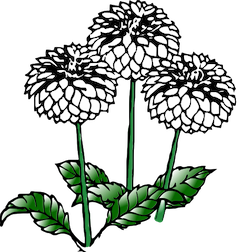 | dahlia society of victoria | LOGIN: |
|
dahlias are easy to growDahlias are not fussy plantsBut they all benefit from pampering Monthly Guide |
If you don't already have your plants you can get them at the Society's auctions and sales as well as retail and specialist nurseries. Click for more info. |
A Short Guide to Growing Dahlias | Use the links for more ideas on getting healthy productive plants |
Dahlias like plenty of sunshine – morning sun, afternoon shade is preferred. Full sun is OK but some protection can reduce damage to buds and blooms in hot weather. Avoid roots of trees and large shrubs or climbers. |
Dahlias like a free-draining neutral to slightly acidic soil with lots of organic material. This can be provided by animal manures, compost or a green manure crop dug in before planting. Seaweed and fish-based products improve soil microbiology and aid root development. Slow-release organic fertilisers provide essential nutrients for healthy, disease-resistant, prolific plants. |
In Victoria the best time to plant tubers is from mid October to late November. A systematic approach to staking, labelling and planting will give flowers from February to May and avoid mixing up your different varieties. |
Bedding and border dahlias and some of the smaller types do not generally need support but many dahlias are tall and susceptible to damage from wind and even the weight of their own flowers! The most common support is a stake planted immediately before planting the tuber and labelled with the dahlia's name. Other methods such as mesh or trellises can be used, especially for larger patches. |
Dahlias are resilient and quite forgiving, needing little care in the weeks after planting apart from protection from slugs and snails. But being such rapid growers and prolific producers, they respond brilliantly to pampering as they grow. Use plant food designed specifically for flowering plants. Keep the soil moist and use mulch to conserve water. You may need to provide some extra care and protection in very hot weather. |
New shoots are very vulnerable to slugs and snails. There are also other beasts and blights that can cause problems, from rabbits to viruses to earwigs, mites and mildew. There are treatments, chemical and otherwise, for most of these except viruses - plants infected with virus must be incinerated or sent to landfill. |
Regular harvesting and deadheading will keep your dahlia producing flowers. You can also groom the plant by selective pruning - stopping, disbudding and disbranching - to produce bigger, better blooms. |
Each year your dahlia plant will produce a cluster of tubers as well as months of blooms. Lifting and dividing the clumps will improve the number and quality of flowers and allow you to increase the stock of your favourite dahlias. |
If your ground is free-draining or you can dig and divide in Spring and then replant your tubers immediately. Otherwise tubers need to be lifted and stored over winter to avoid them rotting in wet ground. |
Dahlias can also be cloned by taking cuttings. The process is straightforward and is widely considered to produce better results over time than relying on tuber division. |
You can collect seed from your dahlias and use it to raise new plants. Since Dahlias hybridise so readily you will be creating your own, new varieties. |